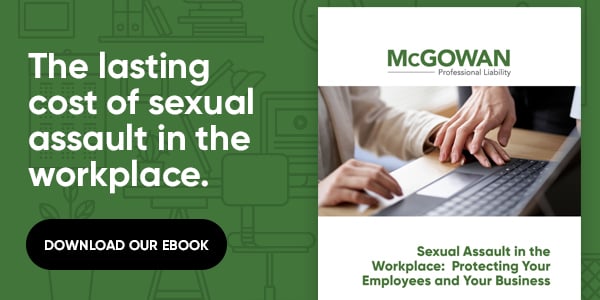Research shows more than eight in ten women experience assault in the workplace within their lifetimes. The recent #MeToo movement has only made the issue more evident for employees and their employers, causing a spike in sexual harassment claims filed with the U.S. Equal Employment Opportunity Commission (EEOC).
With new cases being filed every year, now is the time for businesses to evaluate how they stand against assault in the workplace and what they can do to protect themselves.

How does assault in the workplace affect employees?
The effects on workers are varied and potentially long-lasting. While it may seem that sexual harassment cases would have decreased with the advent of remote working, lines between professional and personal lives have become blurred, allowing for new avenues and opportunities for harassment to take place.
As a result of assault in the workplace, workers may experience harmful effects on their employment status, opportunities for advancement, and mental or physical well-being. Common side effects are anxiety, depression, and trauma, with eight in ten women beginning a new job within two years after experiencing harassment. Perpetrators are also far more likely to remain at a job, while their victims feel driven to leave.
Also read: A Great Employee Retention Plan Starts with Recruiting
The costs for employers
It’s crucial to note that while victims suffer severe consequences, the business also experiences extensive costs. It is in both parties’ best interests to ward against assault in the workplace.
Changes in legislation are also making the effects of sexual harassment more extensive for employers. In 2022, the Speak Out Act was signed into law, targeting nondisclosure and non-disparagement agreements that have historically been used to address misconduct. In response, employers should check existing NDAs, and add language that makes it clear NDAs do not apply to sexual harassment or sexual assault.
Failure to comply with changing legislation can result in long-lasting repercussions:
- Productivity losses: Loss of productivity is a direct result of assault in the workplace, as victims of harassment or bullying are 1.7 times more likely to take at least two weeks off work than those who have not.
- Legal consequences: Financial payouts are usually kept confidential, but businesses can still gain an understanding of the costs by evaluating the EEOC, which earned $46.3 million for victims in 2017. The EEOC litigates only a small number of cases it receives, meaning the number of cases likely far exceeds what payouts represent.
- Damage to reputation: Companies that do not adequately address assault in the workplace claims may find public opinion dwindling. As a result, it could become harder to attract new talent, or employees may leave. Turnover represents the most significant economic cost associated with sexual harassment, as replacing employees is resource intensive and expensive.
Of course, there are many other costs associated with assault in the workplace, such as training expenses, increased security needs, the absence of skilled workers, physical damage to the business, and more.
How can businesses protect employees?
Considering the high costs for workers and employers, it’s in an organization’s best interests to invest in precautions that prevent harassment from taking place. This can represent a complete overhaul of a business’s values, linking anti-harassment to business objectives. In doing so, organizations separate legal compliance from their beliefs, ensuring employees understand the employer actually stands for diversity, equity, and inclusion.
Additionally, businesses should:
- Perform a risk assessment: Identifying potential vulnerabilities and blind spots in the organization, which may have developed further with the move to remote work.
- Communicate the consequences: Staff should understand the consequences of sexual harassment through clear, consistent, and immediate action.
- Train staff: Workplace civility training, bystander intervention training, and training for middle management can help identify issues before they arise.
- Review policies: Updating outdated anti-harassment policies and communicating them to employees will ensure workers understand how to conduct themselves.
When employers take anti-harassment measures seriously, workers have more confidence in their workplace.
Also read: The Inevitable Rise of Employee Fraud and Theft
Additional protection
With the rapidly changing legal and employment landscape, businesses should take all measures possible to protect themselves against assault in the workplace. One way is to invest in insurance.
More than 60% of employee liability claims are filed against small employers, with even one Employment Practices Liability (EPL) claim potentially bankrupting 50% of small businesses. Employers are actually more likely to be sued by an employee than experience property loss. Yet, companies will often invest in property insurance before EPL insurance.
The shifting landscape necessitates businesses take the same precautions against EPL claims as they would for their physical property. McGowan Employment Practices Liability Insurance protects businesses against legal defense expenses and damages resulting from wrongful employment practices such as discrimination, sexual harassment, wrongful termination, and other related workplace issues.

